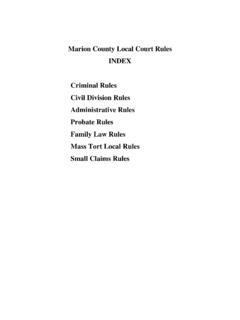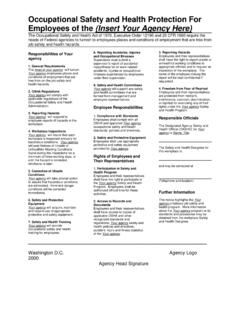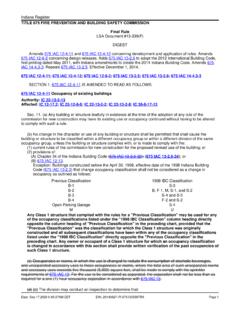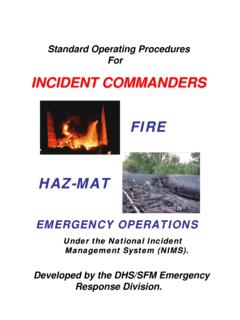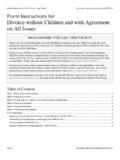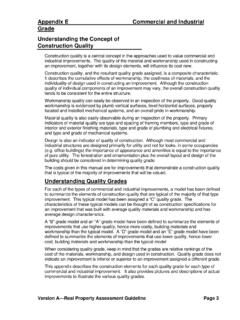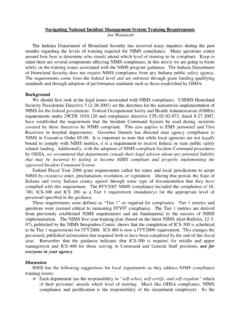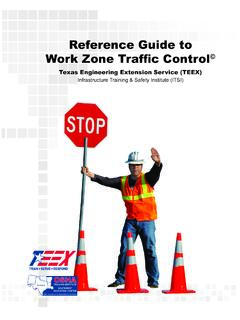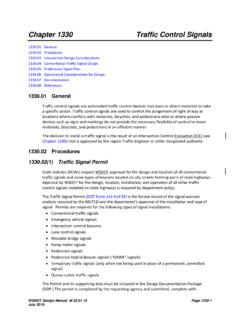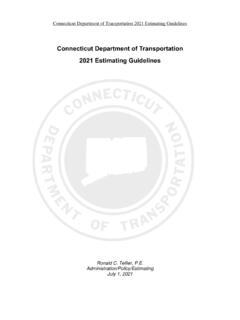Transcription of Temporary Erosion and Sediment Control
1 INDIANA DEPARTMENT OF TRANSPORTATION 2013 design MANUAL. CHAPTER 205. Temporary Erosion and Sediment Control design Revision Sections Affected Memorandum Date 15-06 Mar. 2015 (03). 16-11 Mar. 2016 16-27 Jul. 2016 , , , Fig. 205-1A. TABLE OF CONTENTS. TABLE OF 2. LIST OF FIGURES .. 3. CHAPTER 205 .. 4. GENERAL INFORMATION .. 4. Erosion AND Sediment Control PLAN DEVELOPMENT [Added Jul. 2016] .. 5. Site Analysis [Rev. Jul. 2016] .. 5. Plan Requirements [Added Jul. 2016] .. 7. Plan Information for Erosion and Sediment Control Measures [Added Jul. 2016] .. 8. Temporary Erosion AND Sediment Control MEASURES [Rev. Jul. 2016] .. 8. Protection of Adjacent Areas [Rev. Jul. 2016] .. 8. (01) Silt Fence .. 8. (02) Vegetative Filter Strip [Rev. Jul. 2016] .. 9. (03) Filter Berm .. 10. (04) Sediment Trap [Rev. Jul. 2016] .. 10. (05) Sediment Basin [Rev. Jul. 2016].. 11. (06) Temporary Stable Construction Entrance .. 12. Slope .. 13. (01) Diversion Interceptor.
2 13. (02) Slope Drain .. 14. (03) Temporary Seeding and Temporary Mulch [Rev. Mar. 2015] .. 14. (04) Manufactured Surface Protection Products and Surface Roughening .. 14. Side Ditch .. 15. (01) Check 15. (02) Modified Check Dam .. 15. Inlet Protection [Rev. Jul. 2016].. 16. Quantities [Added Jul. 2016] .. 16. STORM WATER QUALITY MANAGER [Added Mar. 2016].. 16. REFERENCES [Rev. Jul 2016].. 17. FIGURES .. 18. Page 2 2013 Indiana design Manual, Ch. 205. LIST OF FIGURES. Figure Title 205-1A Erosion and Sediment Control Plan Technical Review Checklist [Rev. Jul. 2016]. 205-3A Slope Length for Silt Fence 205-3B Silt Fence Application 205-3C Minimum Filter Strip Application 205-3D Vegetative Filter Strip Application 205-3E Sediment Traps in V-Ditches 205-3F Sediment Traps in Flat Bottom Ditches 205-3G Flood Pool Length 205-3H Sediment Basin Details 205-3I Spacing for Diversion Type B. 205-3J Disturbed Side Ditch Treatment 205-3K Undisturbed Side Ditch Treatment 2013 Indiana design Manual, Ch.
3 205 Page 3. CHAPTER 205. Temporary Erosion . AND Sediment Control . GENERAL INFORMATION. An Erosion and Sediment Control plan, also known as a storm water management plan, should be developed where soil is disturbed, especially where Sediment can enter a waterway or move off site. The Erosion and Sediment Control plan should address Erosion and Sediment Control during the entire construction process. Different measures will likely be used during different phases of construction. Allowance should be made for changes in the field to accommodate existing conditions or the use of different measures where they are more appropriate. The goals of Erosion Control and Sediment Control are different. The purpose of placing Erosion Control measures is to prevent Sediment from being mobilized on the project site. Sediment Control measures are placed to recapture soil that has been mobilized and prevent it from leaving the construction site.
4 Water flowing through a construction-disturbed area is to be filtered of Sediment before it mixes with water which is not affected by construction operations. The guidelines presented in this chapter concentrate on Temporary Erosion and Sediment Control measures. The designer should coordinate with the Division of Environmental Services to determine the need for permanent Erosion and Sediment Control measures. INDOT Standard Specifications and Standard Drawings show existing Temporary Erosion and Sediment Control measures available to the designer. The Erosion and Sediment Control measures described herein have been listed in groups according to their use. Some of the measures may be used in multiple applications. These guidelines will aid the designer in choosing the appropriate measures and frequency of their use. Erosion and Sediment Control measures should be designed at a minimum for a 2-yr 24-h rain event unless otherwise stated.
5 An Erosion and Sediment Control plan known as a Storm Water Pollution Prevention Plan (SWPPP), is required to be submitted to the Indiana Department of Environment Management (IDEM) to comply with 327 IAC 15-5 (Rule 5). Rule 5 Notice of Intent (NOI) is a key component of the permitting process in order to maintain compliance with other waterway permits such as 404, 401, and DNR permits. See the INDOT Waterway Permits Manual at for additional permit information. Formal submittal to comply with Rule 5 is required where 1 acre or more is disturbed. A copy of Rule 5 Notice NOI is available via the IDEM website, at . It lists Page 4 2013 Indiana design Manual, Ch. 205. items that should be submitted to IDEM with the Erosion and Sediment Control plan. The designer should consider all items listed in Figure 205-1A Erosion and Sediment Control Plan Technical Review Checklist. The Erosion and Sediment Control plan should be prepared and submitted to IDEM.
6 The NOI letter should be filed with IDEM. The submittals should be as follows 1. Plans developed for an INDOT project will be filed by the Environmental Services Division permit coordinator. 2. Plans developed for a local public agency project will be filed by the local agency or its representative to the Soil and Water Conservation District. 3. Plans developed by a contractor, , design build or lump-sum Erosion Control , will be signed by the contractor first and then by the Environmental Services manager or representative. Plans are submitted to IDEM by the contractor. Erosion AND Sediment Control PLAN DEVELOPMENT [ADDED. JUL. 2016]. Site Analysis [Rev. Jul. 2016]. The Erosion and Sediment Control plan should identify Control measures that will be used to minimize Erosion and off-site sedimentation. It serves as a blueprint for the location, installation, and maintenance of these measures. In preparing the Erosion and Sediment Control plan, the designer should start by observing local and regional drainage areas, geometric site constraints, and topography.
7 The volume of water entering and leaving the construction site at various locations should be considered. Where reasonable, off-site waters should be isolated and allowed to pass through the project site. Sediments from on-site sources should be captured prior to leaving the site. The method of treatment depends upon the drainage area. Providing a vegetated ground cover is most important in terms of preventing Erosion . If the existing vegetation is to be disturbed, appropriate Erosion and Sediment Control measures should be utilized. If utility features traverse the site, their relocation should be considered in designing these measures. The following principles of Erosion and Sediment Control should be utilized. 1. The physical characteristics of the site should be assessed, including topography and drainage, to determine how to best minimize Erosion and sedimentation. 2013 Indiana design Manual, Ch. 205 Page 5. 2. The Erosion and Sediment Control plan should be designed to include measures that will keep Sediment on the construction site as much as possible.
8 3. Where reasonable, a diversion interceptor or waterway should be used to divert or intercept off-site runoff. If the designer determines that the use of a diversion interceptor for off-site runoff is not practical, the designer should increase the size or quantity of proposed Erosion and Sediment Control measures to satisfy the additional volume of water being treated from off-site runoff. 4. Measures to slow runoff and allow deposition of Sediment should be designed using grading and Sediment barriers to break up a long, steep slope. 5. A Temporary seeding quantity in accordance with (03) should be provided for each area of disturbed soil. 6. Runoff velocity should be reduced by means of maintaining existing vegetative cover, preserving a natural buffer strip around the lower perimeter of the disturbed land, and installing perimeter controls such as silt fences, filter berms, and Sediment basins or traps. 7. The contractor should be provided adequate working space to construct, repair, and maintain Erosion Control features.
9 8. A typical Erosion Control design is believed to comprise 1% of the estimated construction cost. The designer should use this threshold of 1% as a check in their design process. When the estimated Erosion Control cost does not reach the 1% threshold, the designer should review the plan and either make revisions or provide a design justification for not meeting this spending threshold which is intended to protect adjacent properties and Waters of the US. 9. No Erosion and Sediment Control measures can be placed within a jurisdictional waterway or wetland unless permitted through the IDEM 401 and/or Corps of Engineers 404. permitting processes. The construction clear-zone should be considered when selecting the appropriate Erosion Control measures. Chapter 82 includes the information necessary to determine the construction clear- zone. For example, traversable check dams such as straw bales, fiber rolls, or fiber socks should be used instead of riprap check dams inside the construction clear-zone.
10 Page 6 2013 Indiana design Manual, Ch. 205. Plan Requirements [Added Jul. 2016]. The project plans should include Temporary Erosion and Sediment Control plan sheets to provide general information and to detail the specific Erosion and Sediment Control measures to be utilized. Figure 205-1A provides a checklist of the items that are required to be shown on these plan sheets. One of the important purposes of the Temporary Erosion and Sediment Control plan sheets is to provide an overall view of the drainage pattern in the areas both adjacent to and within the project site. The following checklist items are important to achieve this purpose: 1. Locations where off-site drainage will enter the project site. Where a defined channel is present, the drainage area and stream name, if available, should be labeled on the plan sheet. If no defined channel is present, the area draining towards the site should be delineated on the plan sheet and be labeled with the drainage area.


